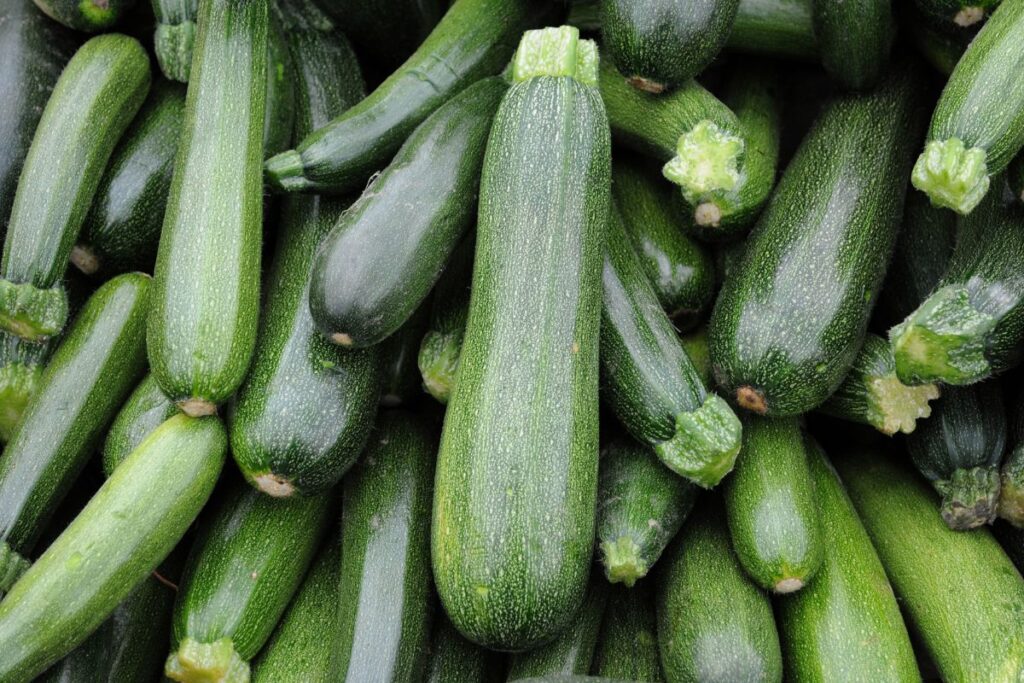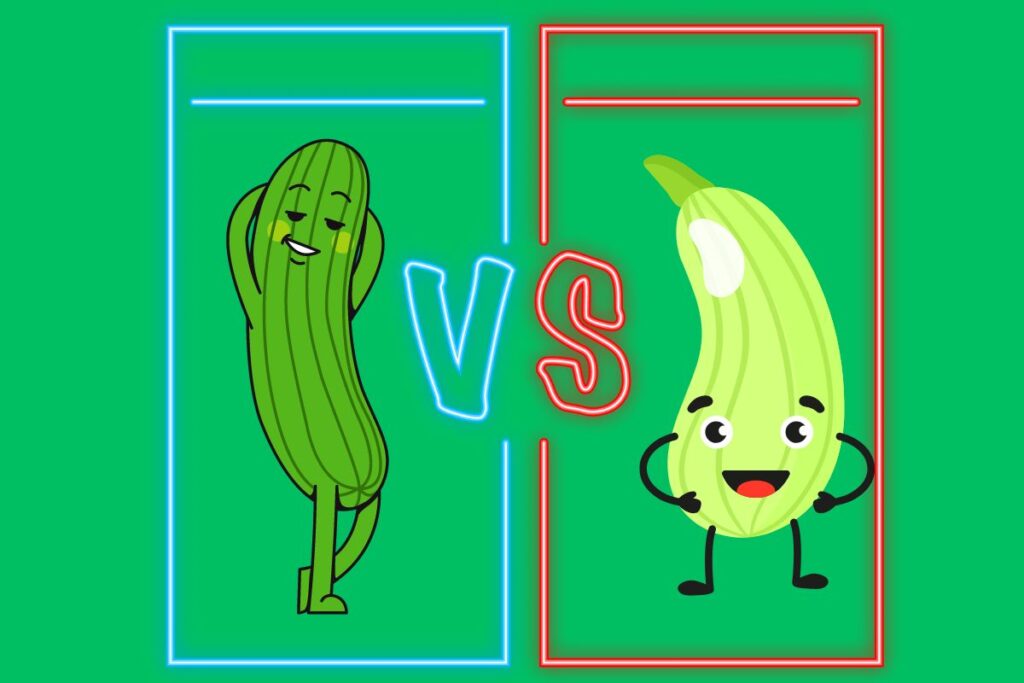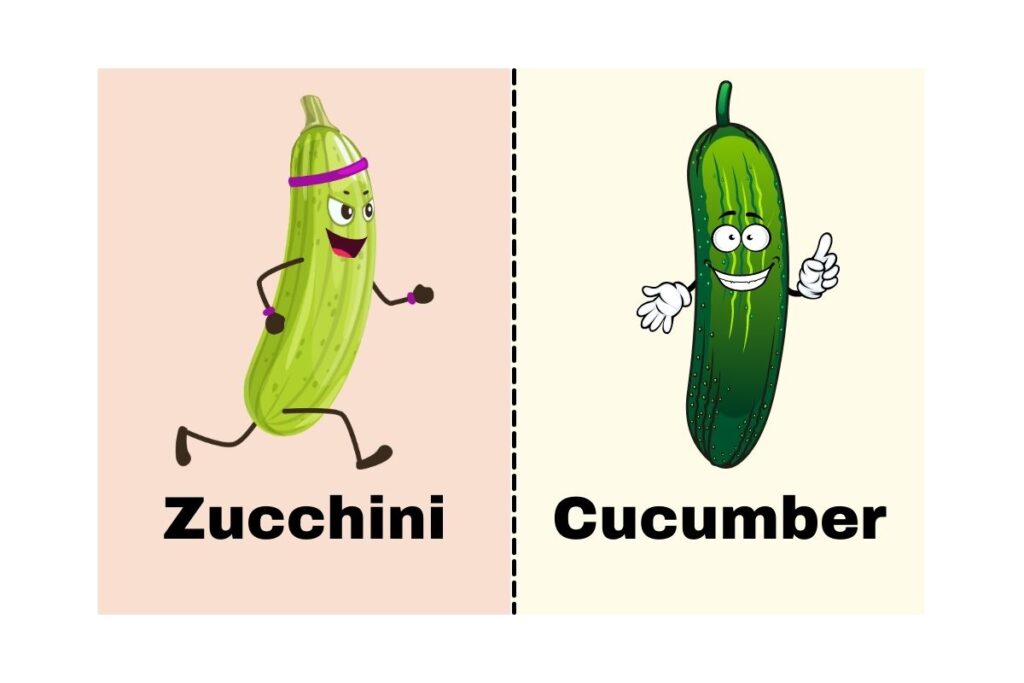Cucumbers and zucchinis are two of the most popular vegetables around the world. They are both members of the Cucurbitaceae family and are used in a variety of culinary applications. Despite their similarities, there are distinct differences between cucumbers and zucchinis.
This article will explore the characteristics, nutritional values, culinary applications, and differences between cucumbers and zucchinis.
Here’s the table of differences between cucumber vs zucchini.
| Characteristic | Cucumber | Zucchini |
| Shape | Cylindrical | Cylindrical with a slightly tapered end |
| Skin Color | Green | Dark green or yellowish-green |
| Texture | Soft | Firm |
| Flavor | Mild | Slightly sweet |
| Culinary Use | Often eaten raw and used in salads or sandwiches | Often used in soups, stews, casseroles, or grilled as a side dish |
| Calories | Low | Higher than cucumber |
| Best Stored | In the refrigerator | In the refrigerator |
What is a Cucumber?

Cucumbers are cylindrical in shape and usually have green skin. They are often eaten raw and used in salads or sandwiches. There are several varieties of cucumbers, including Armenian cucumbers, Japanese cucumbers, and English cucumbers.
Cucumbers have a high water content, which makes them refreshing and hydrating. They are low in calories and an excellent source of vitamin K and vitamin C. Cucumbers are also known for their anti-inflammatory and antioxidant properties, which help to protect against chronic diseases.
They can be used in a variety of ways, including as a salad ingredient, as pickling, or as a snack.
What is a Zucchini?

Zucchinis are also known as summer squash and have a cylindrical shape with a slightly tapered end. They have a dark green or yellowish-green skin and are often used in soups, stews, casseroles, or grilled as a side dish.
There are several varieties of zucchini, including golden zucchini, crookneck zucchini, and zucchini blossoms. Zucchinis are low in calories and an excellent source of vitamin C, vitamin A, and potassium.
They are also high in antioxidants, which help to protect against chronic diseases. Zucchinis are versatile and can be used in various culinary applications, including in soups, stews, and casseroles.
Related Reading:
- 8 Zucchini Planting Tips For Best Harvest
- How To Clone Tomato Plants From Cuttings?
- How to Plant Eggplant in Plastic Bottles?
Cucumber Vs Zucchini: What’s the Difference?

While cucumbers and zucchinis share some similarities, there are also some key differences between the two vegetables. These differences can impact their culinary use, nutritional content, and health benefits.
Some of the key differences between cucumbers vs zucchini include:
- Shape and skin color: Cucumbers are typically cylindrical in shape with green skin, while zucchinis are cylindrical with a slightly tapered end and dark green or yellowish-green skin.
- Texture: Cucumbers have a soft texture, while zucchinis are firmer in texture.
- Flavor: Cucumbers have a mild flavor, while zucchinis are slightly sweet.
- Culinary use: Cucumbers are often eaten raw and used in salads or sandwiches, while zucchinis are often used in soups, stews, casseroles, or grilled as a side dish.
- Nutritional content: While both cucumbers and zucchinis are low in calories and high in vitamins and minerals, zucchinis are higher in calories and are an excellent source of vitamin A and potassium, while cucumbers are an excellent source of vitamin K.
Understanding the differences between cucumbers vs zucchini can help you make informed choices when it comes to incorporating these vegetables into your diet.
Whether you prefer them raw or cooked, both cucumbers and zucchinis offer a variety of health benefits and can be enjoyed in many different ways.
Cucumber Vs Zucchini: What Are Similarities?

Cucumbers and zucchinis share some similarities in their nutritional profiles and health benefits. Both vegetables are low in calories and high in water content, making them a great choice for anyone watching their weight or looking to stay hydrated.
Additionally, both cucumbers and zucchinis are rich in vitamins and minerals that are essential for optimal health.
Some of the key similarities between cucumbers vs zucchini include:
- Low in calories: Both cucumbers and zucchinis are low in calories, making them a great option for anyone looking to maintain a healthy weight.
- High in water content: Cucumbers and zucchinis are both high in water content, which makes them a refreshing and hydrating addition to any meal.
- Rich in vitamins and minerals: Cucumbers and zucchini are both rich in vitamins and minerals that are essential for good health. For example, both vegetables are high in vitamin C, an antioxidant that supports a healthy immune system.
Related Reading:
- Kheera, Cucumber, and Kakdi – Understanding the Differences
- Why Are My Pumpkin Flowers Falling Off?
- How To Grow Delicious Danvers Carrots?
Conclusion
To summarize, cucumbers and zucchinis are both nutritious and versatile vegetables. While they may look similar, they have distinct differences in flavor, texture, and culinary applications.
Knowing the differences between cucumbers vs zucchini can help you select the best vegetable for a particular recipe or dish. Both cucumbers and zucchini can be easily incorporated into a balanced diet, and their nutritional values make them a great addition to any meal.
It is important to select fresh cucumbers and zucchini and store them properly to maintain their quality and freshness.







